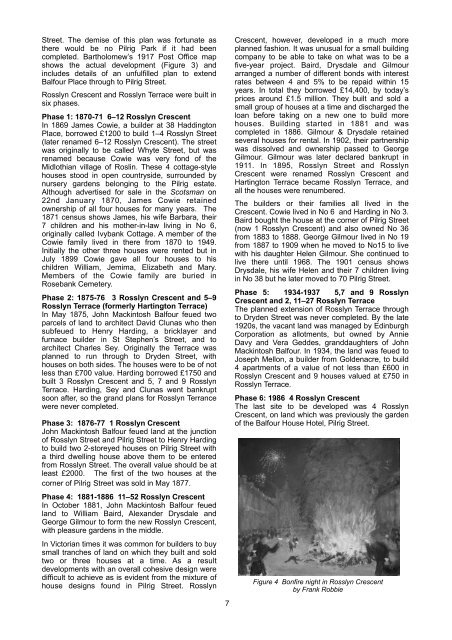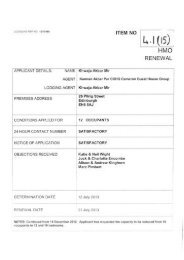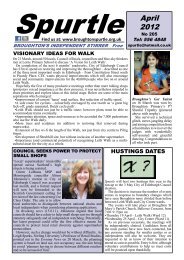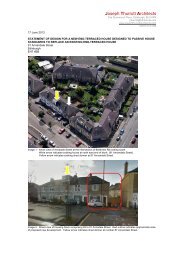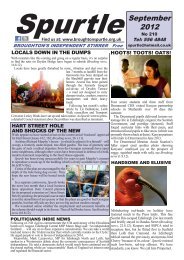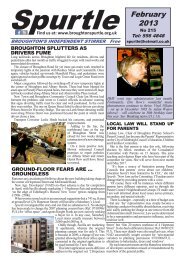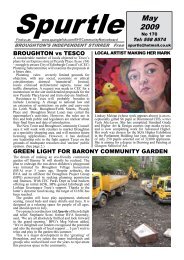BROUGHTON HISTORY SOCIETY NEWSLETTER - Broughton Spurtle
BROUGHTON HISTORY SOCIETY NEWSLETTER - Broughton Spurtle
BROUGHTON HISTORY SOCIETY NEWSLETTER - Broughton Spurtle
You also want an ePaper? Increase the reach of your titles
YUMPU automatically turns print PDFs into web optimized ePapers that Google loves.
Street. The demise of this plan was fortunate as<br />
there would be no Pilrig Park if it had been<br />
completed. Bartholomew’s 1917 Post Office map<br />
shows the actual development (Figure 3) and<br />
includes details of an unfulfilled plan to extend<br />
Balfour Place through to Pilrig Street.<br />
Rosslyn Crescent and Rosslyn Terrace were built in<br />
six phases.<br />
Phase 1: 1870-71 6–12 Rosslyn Crescent<br />
In 1869 James Cowie, a builder at 38 Haddington<br />
Place, borrowed £1200 to build 1–4 Rosslyn Street<br />
(later renamed 6–12 Rosslyn Crescent). The street<br />
was originally to be called Whyte Street, but was<br />
renamed because Cowie was very fond of the<br />
Midlothian village of Roslin. These 4 cottage-style<br />
houses stood in open countryside, surrounded by<br />
nursery gardens belonging to the Pilrig estate.<br />
Although advertised for sale in the Scotsman on<br />
22nd January 1870, James Cowie retained<br />
ownership of all four houses for many years. The<br />
1871 census shows James, his wife Barbara, their<br />
7 children and his mother-in-law living in No 6,<br />
originally called Ivybank Cottage. A member of the<br />
Cowie family lived in there from 1870 to 1949.<br />
Initially the other three houses were rented but in<br />
July 1899 Cowie gave all four houses to his<br />
children William, Jemima, Elizabeth and Mary.<br />
Members of the Cowie family are buried in<br />
Rosebank Cemetery.<br />
Phase 2: 1875-76 3 Rosslyn Crescent and 5–9<br />
Rosslyn Terrace (formerly Hartington Terrace)<br />
In May 1875, John Mackintosh Balfour feued two<br />
parcels of land to architect David Clunas who then<br />
subfeued to Henry Harding, a bricklayer and<br />
furnace builder in St Stephen’s Street, and to<br />
architect Charles Sey. Originally the Terrace was<br />
planned to run through to Dryden Street, with<br />
houses on both sides. The houses were to be of not<br />
less than £700 value. Harding borrowed £1750 and<br />
built 3 Rosslyn Crescent and 5, 7 and 9 Rosslyn<br />
Terrace. Harding, Sey and Clunas went bankrupt<br />
soon after, so the grand plans for Rosslyn Terrance<br />
were never completed.<br />
Phase 3: 1876-77 1 Rosslyn Crescent<br />
John Mackintosh Balfour feued land at the junction<br />
of Rosslyn Street and Pilrig Street to Henry Harding<br />
to build two 2-storeyed houses on Pilrig Street with<br />
a third dwelling house above them to be entered<br />
from Rosslyn Street. The overall value should be at<br />
least £2000. The first of the two houses at the<br />
corner of Pilrig Street was sold in May 1877.<br />
Phase 4: 1881-1886 11–52 Rosslyn Crescent<br />
In October 1881, John Mackintosh Balfour feued<br />
land to William Baird, Alexander Drysdale and<br />
George Gilmour to form the new Rosslyn Crescent,<br />
with pleasure gardens in the middle.<br />
In Victorian times it was common for builders to buy<br />
small tranches of land on which they built and sold<br />
two or three houses at a time. As a result<br />
developments with an overall cohesive design were<br />
difficult to achieve as is evident from the mixture of<br />
house designs found in Pilrig Street. Rosslyn<br />
7<br />
Crescent, however, developed in a much more<br />
planned fashion. It was unusual for a small building<br />
company to be able to take on what was to be a<br />
five-year project. Baird, Drysdale and Gilmour<br />
arranged a number of different bonds with interest<br />
rates between 4 and 5% to be repaid within 15<br />
years. In total they borrowed £14,400, by today’s<br />
prices around £1.5 million. They built and sold a<br />
small group of houses at a time and discharged the<br />
loan before taking on a new one to build more<br />
houses. Building started in 1881 and was<br />
completed in 1886. Gilmour & Drysdale retained<br />
several houses for rental. In 1902, their partnership<br />
was dissolved and ownership passed to George<br />
Gilmour. Gilmour was later declared bankrupt in<br />
1911. In 1895, Rosslyn Street and Rosslyn<br />
Crescent were renamed Rosslyn Crescent and<br />
Hartington Terrace became Rosslyn Terrace, and<br />
all the houses were renumbered.<br />
The builders or their families all lived in the<br />
Crescent. Cowie lived in No 6 and Harding in No 3.<br />
Baird bought the house at the corner of Pilrig Street<br />
(now 1 Rosslyn Crescent) and also owned No 36<br />
from 1883 to 1888. George Gilmour lived in No 19<br />
from 1887 to 1909 when he moved to No15 to live<br />
with his daughter Helen Gilmour. She continued to<br />
live there until 1968. The 1901 census shows<br />
Drysdale, his wife Helen and their 7 children living<br />
in No 38 but he later moved to 70 Pilrig Street.<br />
Phase 5: 1934-1937 5,7 and 9 Rosslyn<br />
Crescent and 2, 11–27 Rosslyn Terrace<br />
The planned extension of Rosslyn Terrace through<br />
to Dryden Street was never completed. By the late<br />
1920s, the vacant land was managed by Edinburgh<br />
Corporation as allotments, but owned by Annie<br />
Davy and Vera Geddes, granddaughters of John<br />
Mackintosh Balfour. In 1934, the land was feued to<br />
Joseph Mellon, a builder from Goldenacre, to build<br />
4 apartments of a value of not less than £600 in<br />
Rosslyn Crescent and 9 houses valued at £750 in<br />
Rosslyn Terrace.<br />
Phase 6: 1986 4 Rosslyn Crescent<br />
The last site to be developed was 4 Rosslyn<br />
Crescent, on land which was previously the garden<br />
of the Balfour House Hotel, Pilrig Street.<br />
Figure 4 Bonfire night in Rosslyn Crescent<br />
by Frank Robbie


